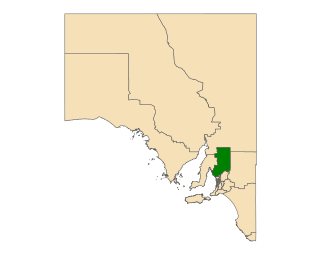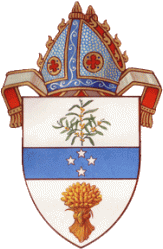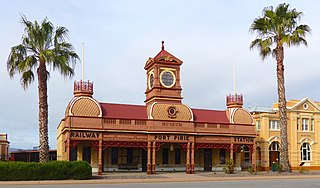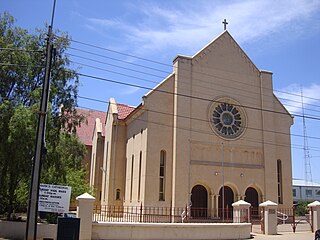Related Research Articles
Since 1970, the South Australian House of Assembly has consisted of 47 single-member electoral districts consisting of approximately the same number of enrolled voters. The district boundaries are regulated by the State Electoral Office, according to the requirements of the South Australian Constitution and are subject to mandatory redistributions by the South Australian Electoral Districts Boundaries Commission in order to respond to changing demographics.

Frome is a single-member electoral district for the South Australian House of Assembly. It is named after Edward Charles Frome, the third surveyor-general of South Australia. The electorate stretches north-eastwards from the Gawler River and Gulf St Vincent in the south, and includes many of the agricultural areas of the Clare and Gilbert Valleys. It covers a total of 12,921 km2 (4,989 sq mi) and takes in the towns of Auburn, Clare, Mintaro, Port Broughton, Saddleworth, Snowtown and Riverton. Prior to the 2020 redistribution, its main population centre was Port Pirie, since transferred to the Stuart.

The Port Pirie Regional Council (PPRC) is a local government area in South Australia, focused on the city of Port Pirie. It has a population of about 18,000 people. The council's main administrative facilities and works depot can be found in Port Pirie; it also have a rural office in Crystal Brook. In addition to Port Pirie, the municipality also includes the surrounding towns and localities of Bungama, Collinsfield, Coonamia, Crystal Brook, Koolunga, Lower Broughton, Merriton, Napperby, Nelshaby, Pirie East, Port Davis, Port Pirie South, Port Pirie West, Redhill, Risdon Park, Risdon Park South, Solomontown, Wandearah East, Wandearah West and Warnertown, and part of Clements Gap, and Mundoora.

The Diocese of Willochra is a diocese of the Anglican Church of Australia. It is situated in the northern and western parts of the state of South Australia, Australia. As part of the Province of South Australia it covers the Eyre Peninsula, Yorke Peninsula and the towns of Coober Pedy, Port Augusta and Minlaton. The diocesan cathedral is Saints Peter and Paul Cathedral in Port Pirie. The diocese was founded in 1915, with Gilbert White installed as the first bishop. The current bishop, since 2012, is John Stead.

Lochiel is a small town in the Mid North of South Australia 125 km (78 mi) north of Adelaide. The town lies beside on the western edge of Lake Bumbunga and at the eastern foot of the Hummocks Range. The Augusta Highway, a section of Highway 1, runs on a strip between the township and the lake, which dwarfs the former.
Stanley was an electoral district of the House of Assembly in the Australian state of South Australia.
Burra was an electoral district of the House of Assembly in the Australian state of South Australia from 1875 to 1902, and again from 1938 to 1970.
Port Pirie was an electoral district of the House of Assembly in the Australian state of South Australia from 1915 to 1970.
Rocky River was an electoral district of the House of Assembly in the Australian state of South Australia from March 1938 to December 1985.

Ellen Street railway station was the second of six stations that operated successively between 1875 and the early 2010s to serve the rural maritime town of Port Pirie, 216 km (134 mi) by rail north of Adelaide, South Australia. Soon after construction of the line towards Gladstone began in 1875, an impromptu passenger service commenced. The inaugural station, Port Pirie South, was 800 metres from the centre of the town. Since two tracks had already been laid down the middle of Ellen Street to the wharves, a small corrugated iron shed was erected as a ticket and parcels office. The street-side location was unusual for the South Australian Railways. In 1902, when passenger traffic had increased greatly, a stone building was erected in a striking Victorian Pavilion style. After the tracks were removed in 1967 and the station closed, the building's design assured its retention as a museum of the National Trust of South Australia.
David Hugh McKee was an Australian politician who represented the South Australian House of Assembly seats of Port Pirie (1959-1970) and Pirie (1970-1975) for the Labor Party. He was Minister of Labour and Industry from 1970 to 1975 under Don Dunstan. David was one of the most progressive politicians of his time making significant contributions towards "South Australia’s pioneering legalisation of abortion and male homosexual acts in 1969 and 1972." Upon his passing, Members of Parliament from both the Labor and Liberal parties recalled his strength of character and some of the legendary tales of Dave's time as the Member for Pirie. David was husband to Rhonda, father to Colin and Laneene, grandfather to Penelope and Matthew and great grandfather to Tabitha, Mitchell and Marley. Dave and Rhonda played a hugely important role in raising their grandchildren after his resignation in 1975, the year his granddaughter was born.

John Christopher Fitzgerald was an Australian politician. A five-time mayor of the Town of Port Pirie, he was a Labor Party member of the South Australian House of Assembly from 1918 to 1936, representing the multi-member seat of Port Pirie.
The District Council of Port Germein was a local government area in South Australia, centred on the town of Port Germein. It was gazetted on 5 January 1888 under the provisions of the District Councils Act 1887 and encompassed the hundreds of Baroota, Wongyarra, Booleroo, Telowie, Darling and Appila. It replaced an abortive earlier municipality, the Corporate Town of Port Germein, which had been established on 15 September 1887 when residents, concerned about increased taxation and their interests being lost in a broader shire under the forthcoming reforms, decided to incorporate the town. The local residents reportedly regretted the decision, and when the Act passed late in the year creating the new District Council, state parliament agreed to amalgamate the Corporate Town into the new municipality.
The Corporate Town of Jamestown was a local government area in South Australia, centred on the town of Jamestown. It was proclaimed on 25 July 1878, severing the seven-year old settlement of Jamestown from the surrounding District Council of Belalie. The first mayor was John Cockburn, later Premier of South Australia, with George Hingston Lake as town clerk. Under the new council, it instituted a tree-planting program from 1879, reportedly the first town in rural South Australia to do so.
The District Council of Crystal Brook was a local government area in South Australia from 1882 until 1988, seated at Crystal Brook.
The District Council of Crystal Brook-Redhill was a local government area in South Australia.
The District Council of Pirie was a local government area in South Australia from 1892 to 1996. It surrounded, but did not include, the city of Port Pirie, which had its own municipal government as the City of Port Pirie.
The City of Port Pirie was a local government area in South Australia from 1876 to 1997, centred on the city of Port Pirie.

St Mark's Cathedral is the main place of Catholic worship in the city of Port Pirie, Australia and is the seat of the bishop of the Diocese of Port Pirie.
Northern District was an electoral district for the Legislative Council of South Australia from 1882 until 1975. Prior to the passing of the Constitution Act Further Amendment Act 1881, the Legislative Council was 18 members elected by people from across the entire Province. From 1975, the Council returned to being elected from the entire State.
References
- ↑ "Statistical Record of the Legislature, 1836 - 2007" (PDF). Parliament of South Australia. Archived from the original (PDF) on 11 March 2019. Retrieved 20 January 2014.
- ↑ "David McKee". Former Member of Parliament Details. Parliament of South Australia.